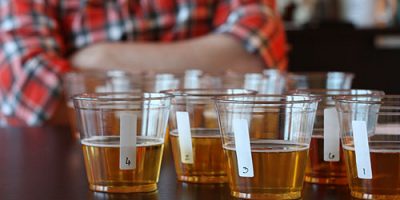 Here’s the first of Seamus’ weeklong series of blog articles about The Beer Trials for the Powell’s website. In the article, he discusses a phenomenon that’s familiar to my experience as well: “conversations about how I could possibly have given famous and best-selling products poor ratings.” It is a basic human instinct, and (for those of us who like to argue, anyway) a great one, to find the first rating that doesn’t comport with your experience and use that as a jumping-off point for debate.
Here’s the first of Seamus’ weeklong series of blog articles about The Beer Trials for the Powell’s website. In the article, he discusses a phenomenon that’s familiar to my experience as well: “conversations about how I could possibly have given famous and best-selling products poor ratings.” It is a basic human instinct, and (for those of us who like to argue, anyway) a great one, to find the first rating that doesn’t comport with your experience and use that as a jumping-off point for debate.
We could answer merely that under blind tasting conditions, the panel didn’t like this beer, or that the beer was boring or flawed. But that would be the boring, flawed answer. All the fun lies in the more substantive defense of each of these ratings and the dialogue that ensues—a dialogue that could well lead to new blind tastings and have a material effect on future editions. What exactly should we be searching for in an ideal European pale lager? Supremely refreshing bitterness, or balanced hop character and greater complexity? (Seamus and I debated this one a lot; the answer, I think, might be connected to how many beers you plan to drink.) That’s why, as Seamus has said, we also really hope you look past the ratings and read the text of the reviews.
It is the more interesting conversation about what constitutes a “good” or “bad” beer, about what it even is to rate beer, and ultimately about the basic philosophical problem of intersubjectivity—that we’re hoping to stimulate. That’s also part of why we chose not just to review the cult beers, but also the everyday beers that are most available around the country. We wanted parts of the book to be familiar to anyone who had ever tasted beer; we wanted to include benchmarks, points of reference, for everyone.
I was happy to see this review of The Beer Trials by Rob Rutledge discuss this engagement with mainstream beers. Rutledge writes: “along with Chimay Blue, they actually DO rate Natural Light! And Bud Light, for that matter, and MGD, and Busch, and every other cheap beer under the sun.” We wanted to see how these beers would hold up in blind tastings. We wanted to praise the ones like Steel Reserve, which outperformed expectations, while calling out the beers like Corona and Heineken, whose premium positioning (compared with entry-level domestic lagers) isn’t supported by much going on in the bottle.
Above all, to start a broad conversation about beer in America while ignoring the country’s most popular beers would be to lose sight of the conversation’s purpose.
I’m looking forward to reading Seamus for the rest of the week at the Powell’s blog. In the meantime, here’s a previously posted preview of the book (including all beer ratings), which is now in stock at, appropriately enough, Powells.com (Portland indy pride!) along with Amazon.


Tim Dellinger
What exactly should we be searching for in an ideal European pale lager? Supremely refreshing bitterness, or balanced hop character and greater complexity?
With all due respect, you’re not really breaking new ground by asking these questions. Discussed since ancient times, written about famously by Jackson in 1977 and Eckhardt in 1989, and then extensively codified by organizations such as the Beer Judge Certification Program and the Campaign for Real Ale, beer style might be an interesting conversation, but it doesn’t really need stimulation.
Likewise, the notions of intersubjectivity and variability in human experience have long ago been addressed, as the scientific method was applied to tasting panels. You may have noticed that food and drink are big business, and that there’s lots of academic literature on these subjects? In these modern times of highly engineered foods/drinks and amazing quality control, and of Netflix/Pandora/etc. not just mentioning that people might have different taste as consumers, but actively advertising their recommendation engines to address the issue, it’s hardly a surprise to people that the issue exists and is a matter of discussion among the buying public, with plenty of meta-discussion about the phenomenon in the popular press by e.g. Malcolm Gladwell (coffee, ketchup, mustard).
So I’m not sure who your target audience is here. There’s an entire craft brewing industry trying to educate the casual beer drinker about the notion of “good” beer. That’s their whole business model. (And a successful one at that.) And they’ve found that most people are not, in fact, capable of being educated.
Akilah Fiala
Lindsay should to be performing a lot more than ninety days in prison, anything less and I think is to total diss towards legal program. She’s already getting off free of charge just mainly because she’s a superstar. It completely sends a harmful message, specially on the kids that adore her as a role model. I am learning now that she will possibly only wind up serving fourteen days of her 90 day time period. I guess driving while plastered is not really so bad after all- the stuff these celebrities get away with is pathetic.